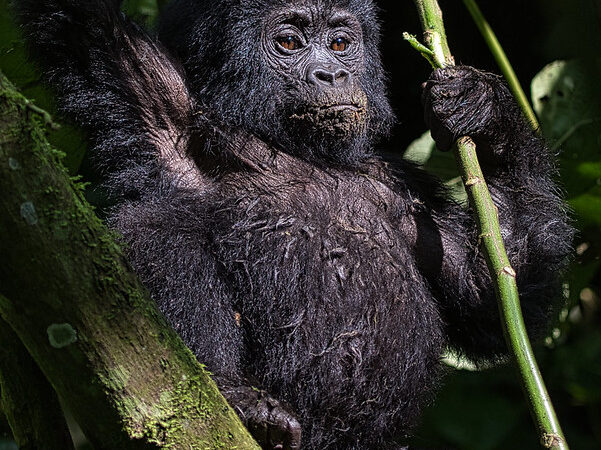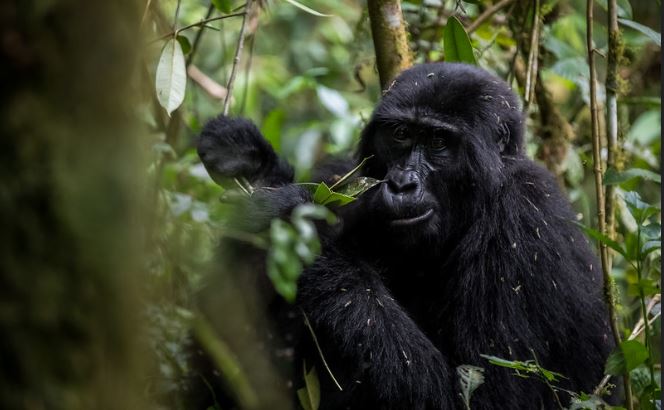New Gorilla Trekking Prices in Uganda 2024: What is the ideal time of year to go gorilla trekking in Uganda, Rwanda, and the Democratic Republic of Congo? The optimal time for gorilla trekking in Uganda varies depending on the season, particularly during the dry seasons, which are from June to August and December to February. During these months, the weather is more consistent, and the paths are drier, making it simpler to negotiate the dense undergrowth.

Nevertheless, is crucial to note that gorilla trekking may be done at any time of year, with each season having its own set of advantages. During the wet seasons (March to May and September to November), the terrain is lush and green, creating a unique experience. The negative is that the pathways can be muddy and slippery, making hiking more difficult.
It is always suggested that you consult with the Uganda Wildlife Authority or a reputable tour operator for the most up-to-date information and recommendations depending on your individual travel plans. Like us at Explore Rwanda Tours, and we will supply you with all of the information you need about gorilla trekking and how to arrange your safari so that you can enjoy your time in Uganda.
New Gorilla Trekking Prices in Uganda 2024.
Beginning of July 1, 2024, gorilla trekking permits in Uganda will increase from USD700 to $800 per person for foreign non-residents, US$700 for foreign residents, and UGX: 350,000 people of East Africa. In Rwanda, gorilla licenses are still priced at USD1500 per person per day. A gorilla permit provides you a 99 percent probability of seeing gorillas.
Seeing mountain gorillas has grown simpler since trackers are frequently deployed into the bush to determine where these enormous animals are on any given day before guests begin on the real hiking expedition.
Where to go for gorilla trekking in Uganda?
After a hard day of trekking to find the gorillas, you are permitted one hour in their presence. Encountering gorillas is a once-in-a-lifetime encounter and exhilarating journey that will leave you speechless.
Gorillas are only found in four national parks: Bwindi Impenetrable Forest National Park and Mgahinga Gorilla National Park in Uganda, Volcanoes National Park in Rwanda, and Virunga National Park in the Democratic Republic of Congo. The Virunga Massive Conservation Area includes both Mgahinga, volcanoes, and Virunga. These three parks share a boundary.
What are the chances of seeing gorillas during gorilla trekking in Uganda?
Whenever it comes to gorilla trekking, many visitors’ biggest concern is whether they will be able to view the gorillas. What happens if I don’t see the gorillas? There’s no reason to worry. In recent years, there have been no reports of people failing to view the gorillas.
Typically, there is a 99% chance of seeing the gorillas, and there has been a successful rate of viewing the mountain gorillas for years. However, there have been cases where our clients have failed or missed to see the gorillas, and this has not been recorded.
Though we can’t predict nature; if a tourist is already in the forest because these creatures move from place to place and sometimes deeper into the forest, it may be difficult to hike the terrain due to its steepness. In such cases, the Uganda Wildlife Authority (UWA) and Uganda Tourism Board (UTB) will step in and improvise where necessary.
Those who return to Bwindi or Mgahinga will be able to monitor gorillas the following day. This is a rare case that has not been reported elsewhere in recent years. Visitors with fitness abilities are requested to indicate their fitness level so that they might be assigned to a gentler walk during the distribution of Gorilla families.
What happens when you fail to see gorillas during your gorilla trekking experience in Uganda?
Upon receiving the gorilla permit, you are supposed to go gorilla trekking. However, nature is unpredictable, and there may be times when you are unable to monitor the gorillas or chimps. In such cases, you should perform the following:
If you are unwell or have a cold, you should not follow the gorillas; instead, stay behind and arrange another date when you will be able to track the gorillas when you are feeling better. The second alternative is to request a refund if you do not recover quickly.
However, you will be needed to provide a medical form to certify the condition, after which the executive director will authorize the revocation of the permit and the repayment of 50% of the permit value to the visitor found unable to monitor gorillas owing to an untreated illness.
How to book a gorilla trekking permit in Uganda?
Booking your gorilla permits should be simple and straightforward. If you wish to book your gorilla permits, you may contact the Uganda Wildlife Authority directly via the phone numbers listed on their websites or by visiting their offices on Kiira Road in Kamwokya, Kampala.
Alternatively, to avoid running up and down, you may just contact us at adventure. I specialize in wild safaris and will handle the difficult task of booking permissions for you. All you need to do is supply us with your information, such as passport photographs, desired dates, year, and month to follow the gorillas.

We will proceed to investigate the availability of permits on your desired dates and get back to you. If available, you will be prompted to submit a deposit in order to secure and confirm your reservation.
When you have finished paying, you will be given a gorilla permit a day before your gorilla trek. The gorilla permit is good for one day and can only be provided to one person per permit; no sharing is permitted.
When should you book your gorilla trekking permit in Uganda?
When and how to book your gorilla permit. Booking your gorilla permit in advance is vital for all people considering a gorilla expedition. Permits are restricted for a certain day, so booking early protects you from last-minute disappointments, and you may find that the permits for that day are sold out.
As a result, all visitors are recommended to arrange their permits at least two to six months in advance, depending on the times they wish to follow gorillas.
When is the best time to go gorilla trekking in Uganda?
The best period to go for gorilla trekking in Uganda varies significantly from year to year owing to weather trends, therefore the information provided here is only a rough guideline. It’s crucial to remember that gorilla trekking is a year-round sport, so the optimal time may vary depending on personal tastes and other circumstances. Here’s the broad breakdown:
Dry Seasons: June-August and December-February
During these months, the weather is often dry and steady.
The routes are less muddy and more accessible, making hiking simpler.
Clear sky may provide improved vision and picture chances.
During the wet seasons (March-May and September-November), the countryside seems lush and verdant.
The rainforests are bright, and there is plenty of greenery.
Trekking in these months may be more difficult owing to muddy and slippery paths.
Although the dry seasons are typically seen as more desirable, some individuals enjoy the lush landscape and distinct mood of the rainy seasons. If you’re hiking during the rainy season, you should be prepared for rain and hard route conditions.
Keep in mind that gorilla trekking permits are limited, so plan well in advance, regardless of the season. Furthermore, the precise location inside Uganda (Bwindi Impenetrable National Park or Mgahinga Gorilla National Park) may have an impact on the weather.


